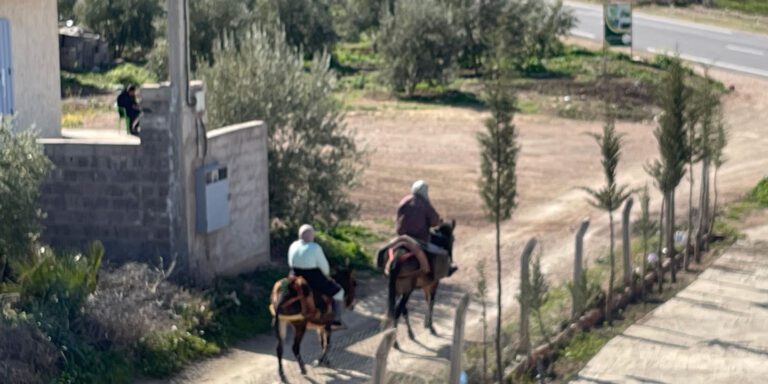
Going through carts of old books, I came across this sad thing.
It felt like a leather-bound book. The spine was battered. But then I noticed what I was holding was a slipcase. It was very thin. When I slipped it out, the next layer was a leather sleeve. When I flipped that open…
Beautiful! Bound in brown-black Morocco. The book was a “time traveler.” The protective layers did their job. The book has traveled since the 19th century to my hands, looking as it did when it left the binder.
But, wait! It got even better. I opened the front board. The free endpaper was silk. But the pastedown just GLOWED with color.
It is called a doublure. The book was a lesson in looking deeper, to not give up on something until you’ve seen it all.
It was also yet another gratifying instance in #bookrescue. The other books in its group were nothing special. Not even remotely as wondrous as this tome. They ALL would have been cast off as a lot had we not cleared out an estate—taking EVERY book.
It is Thursday afternoon. February 2nd.
It turns out I was also Morocco bound.
I spent all day touring through Marrakesh. The city is alive with people and colors and aromas and… excitement!
The first stop this morning was Koutoubia Mosque. It is called the “booksellers’ mosque.” There once was a “souk”—a market—around it for manuscript sellers. Those were the equivalent of books when the building was started in the mid-12th century… nearly 900 years ago. It is stunning.
From there, we went to Bahia Palace. The Bahia Palace, like so many sites in Morocco, the interior is highly decorated. Mostly geometric shapes. The representation of human or animal images is forbidden. That is considered by some to be blasphemous. It was begun in the mid-19th century by a grand vizier to a sultan. All the different titles are still confusing to me. It is a sprawling affair with a gorgeous courtyard and a large riad—or garden. It is full of peaceful birdsong. The vizier was perhaps a hypochondriac or maybe chronically ill. Incised words on the wall in his bedroom repeat “good health” over and over again.
From there, our guide Mo (short for Mohamed) led us to a rug merchant. It was fascinating. We were given a brief lecture about various types. As the man spoke, assistants kept bringing out carpets and unrolling them dramatically. By the time he finished speaking, about 50 had been spread out on the marble floor that we were seated around. The building is from the 14th century, and we were told it had been the grand home of an astronomer. Then we were invited to walk around and shop. Men would come and try to get us interested in carpets they casually unfurled before us. I heard the number $2500 for a beautiful runner.
“These take six months for a woman to make by hand.”
I have plenty of old oriental carpets, so I wasn’t even nibbling. A nice woman from Wisconsin sprung for a big one, though. She wouldn’t tell us the price, but my guess is 15K. Maybe $10,000?
Depends how much dickering she did. The carpet was beautiful. This one took fifteen months to make.
From there, we walked to a tomb complex from the 16th century. It had been walled up by a later, jealous sultan to hide his predecessors’ grandeur. It was only rediscovered in 1917 by French archaeologists. There are graves of several sultans in sumptuously decorated “rooms.”
Then we were taken to a spicery/pharmacy that is vetted by Globus. 100,000 Epices. There’s a fun video of the place on their website. At the entrance, a woman in native garb was seated on the ground grinding argan nuts for the oil that supposedly has many healthy virtues. She spun a stone “wheel” round and round, and a brown liquid with the consistency of liquidy peanut butter dripped into a pot.
We were taken into a room whose walls were lined with liquids and powders that can cure anything you can name—including bad cooking. This was assured to us by a young woman who presented one product after another (and another and another…) She would pass around jars or other containers for us each to take a whiff of. She wore a white lab coat and spoke authoritatively, so all of it must have been true. I bought two packs of culinary herbs that smelled divine. And I bought some argan oil because she assured us it had rejuvenating properties.
“I use it myself, and I am actually 90 years old!”
We got on the bus for a short ride to the vast open market. In the square, there were snake charmers and guys with Barbary apes on chains. Fortunately, Mo cautioned us on how to avoid being caught in scams by these folks. He also told us recommended cafes.
“Don’t eat anything uncooked. Not even salad!”
It was an unbelievable melange of the tragic. (Beggars displaying missing or rotting limbs.) To the comic. (An old dancer conning tourists into wearing hats and spinning, so the tassels go round and round in the rhythm of drums and “flutes” being played.) The ancient market extends upward and in all directions. I entered a vast warren of booths in narrow dark alleys. This section was so vast and complex that I had to use my phone to guide myself back outdoors to the square. I walked and walked and walked. Finally, it was time to rendezvous. We got on the bus—most of us—some either got lost or found their own way back.
I need to cut this short at Thursday afternoon. I’m walking to the Mamounia Hotel for a cocktail. The hotel is iconic. It was a favorite of Winston Churchill. To say the bar is stunning, a masterpiece, is an understatement. I had two incredible vespers last night. That was one too many after the exhausting trip from Fez.
I’ve got to get back as some of us signed up for a dinner. 1001 Nights in… something or another.
I booked this trip with Globus over a year ago. I got an email about a super sale. A week for under $1000. I forwarded it to my travel agent Tim at Welcome Aboard. (He is wonderful, by the way. He makes sure I don’t spend hours splitting hairs on airfares and schedules. If there’s a problem—like a new COVID protocol in a foreign land—he is on top of it!)
“Do you want any extra days?”
(This has been a great idea of his. If I get in a day or two early, I can scope out what I want to see outside of the tour. Also, I have a day to catch up on the time change. AND if there is some delay, I don’t miss the beginning of the tour. Staying a day or two late gives me the option of seeing things I saw but couldn’t get to because of tour constraints.)
“Yes. One day before and one day after the tour.”
Morocco… It wasn’t at the top of my bucket list, but at that price… well, and thinking about it… it sounded like an adventure.
Tim arranged the flights. He remembered the nightmare I’d had in Paris in 2021. The time between flights had been about two hours. But that hadn’t accounted for the distance between gates and the security obstacles. Turns out since Paris was my first stop in the EU, I needed to go through customs, get my baggage screened… Though I moved at a pace just below a jog, I was the last one on board the flight to Naples. That included waving my ticket at a security person who inspected it and pulled me out of a long line to get my passport stamped—after all the other stops. Some travel mates didn’t make it. When I got to Naples, the transfer minibus was supposed to have 8 travelers. I was the only one that got through. The driver took me all the way to Sorrento as the sole passenger.
So I agreed to a layover of 4 plus hours in Paris. 8 a.m. til noon.
I’m tired. It feels like 2 a.m. I slept maybe four hours.
At the very far end of Terminal K in DeGaulle, there is a huge arcing window that provides a wonderful view from a large quiet waiting area. Chairs are screwed to the floor. I am alone on the bottom level. What I am looking out on is a couple miles of tarmac and dozens of parked jets. Tail after tail after tail.
The hot coffee pours through me, fortifies me. Starbucks. It required no learning curve. “Americano Venti, sil vous plais.”
It is a day to push through.
I will hopefully be in Casablanca at 3 p.m.
Then… no plans.
I suppose I will walk.
There’s a glass box above and to the left of me. A half-dozen people stand in it smoking. Virtually on display. A box of shame?
Directly in front of me down on the pavement is a depot for those very low vehicles that tow planes. A dozen people—it appears to be all men—stand outside a box of an office. They wear day glow yellow vests. One at a time, they go inside. I suppose in there they are given an assignment. Some vehicle that they will drive somewhere and do… something.
One big guy—6’2″ is hugging many of the other workers. He leans in and busses the right cheek and then the left.
How very French. For some reason, I think of COVID. A close relation has it. All shot up but has no sense of taste now.
It is strange to be here. All alone in a very large space. Up some steps and behind me are hundreds, maybe thousands.
High-end shops. Hermes, Bulgari, Cartier…
There is quiet time, time for reflection.
…
Africa…
The word “breathes.” The last syllable is a soft exhalation. Mystery. Another world on this planet.
I brought a sheaf of recently rediscovered papers and a yellow legal pad that has slept with me for a few months. All “poems.” The pad has dates since October. The loose sheets are dated going back to 2004. Some are undated.
I will kill some time transposing some of them.
Who was I then? Maybe I’ll find out.
2010
The book lives on
– Amazon Kindle
That is no longer the written word
Electronic ephemeral
Frenetic electrons tossed
upon a plastic screen
You hold nothing
You touch nothing
Push the button
Flip the switch
Pull the plug
E-book E-life
E-culture E – Empty
This was written a dozen years ago. It’s not very sophisticated, but it reflects the time. The E-Readers were considered a threat to the printed book.
“What will you do when they stop printing books?”
This was not an unusual question from doomsaying customers at the time.
I had concerns.
But I also had faith.
People love the printed page. People love the bound book. It is a comfortable fit for the human hand.
My heart was correct, as it turns out. More books are being printing each year—since 2012, I think.
And for Wonder Book and Books by the Foot, we are selling more books online than ever. Even the stores have had a renaissance. All the hard work over the years. It keeps it fun to have growth.
With so much down time, I got a lot of verse transposed. When I get back, I will print it out. Then I can put the manuscripts in a milk crate labeled “Done.”
The printouts go in milk crates in my bedroom and in the office at the warehouse.
… I got caught up on a lot of old and not so old slices of life.
A friend whose literary credentials are impeccable recently said at a dinner, “You’re a poet.”
I basked in that for a moment, but with the usual cynicism I bear for myself, I thought, ‘He didn’t say I was a good poet.’
Well, better to have tried and failed rather than regret what I should have attempted.
The boarding in Paris took forever. We were shuttled to the plane in a bus. Check-in took forever. A couple of people were turned away.
“You cannot go to Casablanca… Your papers are not in order.” Just like the movie, but these folks couldn’t get INTO that city.
Finally, the last bus came, and the stragglers took their time finding the last seats (AND finding there was no place to put their bags.) When the door closed, an old man somewhere in the back started raving loudly.
“A… BLAHBLAHBLAH! … AYEYIYI! …” It had the cadence of a chant at times, but it was clearly a crazy rant. Was he upset at the late departure?
Necks turned and craned backward. Curiosity mixed with “will this escalate?” and “should I be ready for fight or flight?”
I just stared ahead.
When I was in my early 20s, I went to the 7-11 just off Viers Mill Rd. in Rockville, Maryland. It was late at night—after midnight. I was out for snacks. After I parked, I observed some yahoo who wandered out of the woods onto the parking lot. Clearly stoned or drunk, he swayed as he walked. I looked, and he made eye contact.
Big mistake.
When I came out with my Slurpie and chips, he started ranting and raving at me—the only other person in the parking lot.
He screamed something at me. Probably “What are looking at, m…f…?”
I got into my blue Ford Maverick, and he rushed over and began pounding on the roof. Out of nowhere, a cop appeared. Then another. I guess they had him staked out in the woods nearby. They had him on the pavement with his hands behind his back and cuffed in a flash.
I got out of my car. My roof had a big dent in it.
I learned then—never make eye contact with a crazy person.
I went to the jail to fill out a report. He must have been in a cell by the time I got there. Nothing ever happened—to my claim, anyway. I don’t know what happened to the psycho.
The guy behind me on the plane to Morocco? Someone in my tour group was also on that plane. They were back closer to the screaming. They said he was an older guy being deported. Inconsolable, he cried with tears streaming down his face for a long time before quiet despair set in.
One said the crew locked him in a bathroom for a while to calm down.
A small drama for the rest of us. A huge event for the old guy.
A scene in the Human Comedy.
Over the Mediterranean and then west over the Atlantic.
To the left I see the west coast of…
… Africa.
A little while later, the jet begins a gentle arc east. And there, just beyond some puffy clouds, Casablanca. It has more tall buildings than I would have thought.
We arc more, and then the plane descends and glides through a layer of clouds. We break through the ceiling, and there is Africa below.
It is much greener than I would have thought. Fields and fields. No real trees…
Casablanca.
The trip into the city was long. We ended up being a few hours later than expected.
I was exhausted physically but excited mentally.
Check-in went quickly, but because of the delays, it was after 7 before I was able to dump my stuff.
I had chatted with some folks that had been on my flight and therefore on the minibus transfer. I asked what their plans were. They were going to stay in. That made sense. It was a dark and mysterious city we had driven through to get to the hotel.
I assumed we would tour the city, but I wanted to do something that the tour wouldn’t. I’d gone to Barnes and Noble to get an up-to-date guide. In the section about Casablanca, there wasn’t a lot of interest to me except Rick’s.
If you are of a certain age, you are probably a lifelong fan of the film Casablanca. If you have never seen it, you have missed what has traditionally been called the greatest movie ever. Maybe it hasn’t stood the test of time?
It is in black and white. All the actors in it are long dead. World War II and its threat to the entire globe is fading into distant history as the participants age into their late 90s and older.
Oh, but the lines and scenes and cinematography and casting… When I was in college and after, I could recite so many of the lines—mouthing the words as the actors were speaking their lines.
“Round up the usual suspects.”
Scenes can still cause tears to flow.
“What are you going to do, Chuck?” a woman asked me.
“I’ve always wanted to go to Rick’s Cafe Americain, but I don’t know…”
“You should go!”
I should. I may never get the chance again.
How?
I don’t speak any Arabic. I didn’t change any money. I had no idea where I was or where Rick’s was in the city. Cabs? Do they accept credit cards? $$? Euros?
Cash. It always works.
“Is there a change place nearby?” I asked the receptionist.
“Turn left and then left again. 500 yards on the left.”
“Its open?”
“Until 9.”
“How much do it get back from $100 cash?” I asked the guy behind the glass.
“990 Dirhams. No commissions.”
‘Good,’ I thought. ’10 cents each. Easy math.’
Back to the hotel.
“Cabs? How much?”
“Petit cabs are metered now.”
The Petit cabs are everywhere. Very small, usually battered, red subcompact cars. Three passengers at the most.
I stood on the sidewalk in font of the hotel and took a leap of faith. I put my arm up to flag down a cab. One slowed and then picked up a young man a few paces in front of me. It then pulled up next to me.
Huh??
The passenger’s window rolled down. The driver leaned over and looked up inquisitively.
“Rick’s? How much?”
“5 Euros.”
“Dollars?”
He nodded.
I got in back.
The driver, an older man, chatted with his young passenger. Then he handed him some money and let him out after a few blocks.
His son? Giving him dinner money?
He weaved through the traffic and scooters and pedestrians. To say traffic is hectic is an understatement I was to find. The guidebook had warned me.
“Traffic guidelines are just a suggestion to drivers. Scooters… have no rules. None. You must protect yourself when crossing streets.”
We got near the marina with its ships and cranes, and then the driver pulled to the side of the road.
“Rick’s.” He pointed to a white building on the left. It was unobtrusively signed.
Wow… Casablanca.
I’d put on a jacket—the blue near-corduroy one I’d bought at a used clothing charity shop in Berlin in October and a black Oxford shirt.
I approached, and the doorman sized me up.
“Do you have a bar?” (Ummm… you never know. But it was a stupid question.)
I entered, and I felt I was in the 1940s—only it was in color.
I stepped past the piano and bass and drums.
And the bar—at Rick’s.
Wow. Chalk off a big one.
Eventually, the bartender noticed me, though I was the only one at the bar and the restaurant only had a few tables occupied. I’d been studiously ignored. That is de rigueur in some places around the world.
He wore a maroon fez and a dark jacket that had a kind of Nehru collar.
“Gin martini very dry?” I asked.
He nodded and eventually got around to stirring it in a stainless steel shaker.
It was beautiful.
‘This might be the high spot of the tour,’ I thought to myself.
And it was. At least so far.
I had a second and then asked for a menu.
I wasn’t very hungry but asked out of politeness and curiosity. It just looked too good. I chose salmon with a Maltese sauce. It was magnificent.
Now, how to get back to the hotel? No cabs.
My phone map was working, although the battery was getting low. I put in the hotel’s address, and a blue line appeared with the route.
“37 minutes.”
I left Rick’s and turned left, and soon I was on one of the strangest walks I’ve ever had. For about a mile, I walked through a narrow walled medina or souk or street market.
I was now dark, but the meandering market had occasional dim yellowish streetlights.
The way was paved with vendors on the right and left—even at night.
Often the way narrowed to not much more than an alley. Furthermore, passages frequently split off to the left and right. They really looked spooky. A good place to wander into and never get out.
There were vendors almost every step of the way for the mile-long walk. Often it would be a bundled single woman or man seated on a piece of cardboard on the pavement. Used shoes and sneakers are a very popular commodity in these commercial enterprises. Some would only have a half dozen worn pairs or footwear laid before them.
Everything has value here—except the litter, lots of litter—paper mostly—but also orange peels and things—I’d rather not guess their origin.
Eventually, the alley ended and dumped onto a boulevard.
Another 3/4 of a mile, and I was back at the hotel. I’d been on the move—often seated—for over 24 hours.
Sunday
The tour does not begin until dinner at the hotel.
I looked at my new DK Morocco guide. I read through the Casablanca section. The only “Must See” was the Hassan II Mosque. I’d seen it the night before on the walk back. The tower—the tallest religious structure in the world—dominated the view to the west—toward the ocean.
That’s where I headed in the morning. West. Toward the sea.
I knew the way. Down the boulevard and then left into the market. Chicken clucking in stacked wooden cages. Mounds of peanuts 3-feet tall atop a platform with a robed figure behind it. Smaller mounds of spices, grains. Large dull oranges covering the top of a table. A small cat seated on the asphalt staring intently up at a man carving the cheek off a sheep’s head. No one says a word to me or even about me. Again, I am studiously ignored. But everyone is tolerant. I’m not pushed to buy a pair of old sneakers from a mound of shoes about 5-feet tall. If wealth is measured by shoe leather in this market, the proprietor might be the richest in the alleys.
Eventually, my walk dumped out toward the ocean. I just had to aim myself toward the soaring minaret. All the entrances to the vast marble paved courtyard are blocked by temporary railings. The one entrance leads into a building where you can buy tickets. There are no printed guides available that I could see. I was on my own.
The complex was huge. Beautiful gleaming marble construction everywhere.
Geometry is everywhere. Animate figures are not permitted in Islamic art. It is all angles. And some arches. ‘Geometric thinking,’ I thought.
I left the mosque and turned back toward the old town. A seawall with an upper and lower promenade borders the ocean—maybe for miles. Along the promenade were occasional fishermen. They had very long poles, and their lines stretched far out into the sea. Some boys were bathing in a pool in the sea. The temperature was in the mid 50s. The way led to a huge shopping mall. Though the guide warned that most everything was closed on Sundays in this modern multi-level shopping center, the couple hundred stores and food vendors all appeared to be open. Many of the names were familiar. McDonalds, Burger King, Pizza Hut… and on and on.
Exiting the modern mall, I headed into the old part of the city.
There was so much early 20th century architecture. Much of it was Art Deco in style. Most of it was in decay. Faded, peeling, covered by modern or not so modern, shop, coffee and food signs. The guidebook mentioned a cafe where Edith Piaf performed and which was frequented by St. Exupery. Petit Couchet. Hop o’ the Thumb from the Perrault fairy tales. I thought I might stop there for coffee or maybe even a drink. When the phone finally told me I’d arrived, it didn’t look at all inviting.
I just kept on walking. And walking. And walking.
It was fascinating and depressing.
Monday
The bus leaves early for Rabat.
Aren’t we going to tour Casablanca? I understand, though. There is not much to see.
We head north—never going too far from the coast. I can catch glimpses of the Atlantic.
Our tour guide’s name is Mo—for Mohamed. He is a dapper man. He sports a brimmed hat and a gray mustache combed outward. A very narrow beard descends from his lower lip toward his chin. He could have been painted by Velasquez. He carries on a running informative monolog using a microphone from the front seat of the bus.
“We are going along what is called the Barbary Coast. From the 1200s, pirates ruled the seas along this African coast and the southern coast of the Mediterranean…”
They practiced a different kind of slavery. They raided European coastal towns capturing people and taking them back to Africa.
There’s a notable account by an Icelandic minister who describes the experience. Women were especially prized for harems, sale or forced labor.
The Barbary Pirates—a fascinating chapter in history. The fledgling United States had its first war against them.
I think of the Marine Hymn. My brother Joe had been a marine.
“From the halls of Montezuma to the shores of Tripoli…” Tripoli is a city on the north coast of Africa.
The King of Morocco had been the first leader of a country to recognize the United States. There’s a treaty signed by George Washington.
Barbary is named for the Berbers. Berber is a bit pejorative to those people. Roman Emperor Claudius—called them the last of the “barbarians”—cultures he needed to subjugate.
They prefer to go by their ancient name—Amazigh. “Free men.” There’s a Berber language too. It had long been suppressed by the Arab conquerors who took over Morocco 1400 years ago. During the Arab Spring, a concession was made. The Berbers were recognized by the state. Perhaps the King saw what was happening in Libya, Tunisia…
It is one of those ancient languages whose roots are unfindable. It perhaps evolved from a protolanguage. The signs in many parts of the country are now first printed in Arabic then Berber and finally French.
Morocco had been a French Protectorate or colony for many years. France developed much of Casablanca until independence in 1956 from France.
The first stop was Rabat—the political capital of Morocco.
It has always been a kingdom since the conquest 700 AD. The kingdom is now run by the 6th Dynasty. This family has ruled since the 1600s. The current king, Mohammed 6th, has been in charge since 1999. His father ruled for 38 years prior to that.
The country is known for its relative tolerance and coexistence. The last US president negotiated a diplomatic relationship with Israel. There is still a significant Sephardic Jewish community.
We stop and take photos of the royal palace. But the current king only uses that for official functions. After Rabat, we pass his home. It is a vast “ranch.” There are soldiers in various uniforms representing the branches of the military at guard posts every few hundred meters for a couple of miles. We are cautioned that aiming a camera at any in uniform is strictly forbidden and will result in being pulled over.
Mo tells us when we are driving through the Mamora Forest on the way to Fez. It holds 300,000 acres of cork oaks. This country is the 2nd largest producer after Portugal.
Fez
A cool sunny day.
We departed the hotel at 7:45. The first stop was a photo op for the largest Medina in the world.
The white tower—center right—is the oldest university in the world. It was founded by a woman, Fatima, in 879 A.D.
History seems a bit different here. Pre-10th century environments are still viable and occupied. How many “civilized” places in Europe are extant from then?
From there our guide, Mo, took us into the city. We entered the medina. I was glad he was there to lead us. For over 2 and a half hours, he led us through the maze-like complex. I never would have found my way to any of the interesting sites without him. I may never have found my way out either.
A highlight was the tannery.
The “pots” hold dyes. Men stand in them and soak hides in them. The smell is horrible. The job must be very dangerous and toxic. But the leather shops display rainbows of colored shoes, purses, luggage, coats…
Fez. The hat or the city? Which came first? Moroccans actually call the fez a “Turkish Hat.” Tarboosh Turkiye. The hat came with the spread of the Ottoman Empire. The Ottomans never conquered Morocco. Their empire stopped at Algeria. The British merchants visiting the city of Fez began calling the hat they saw there so frequently “fez.”
Wednesday
An early start. Bags out of the room at 6:30. On the road at 7:30.
We are heading south. From Fez to Marrakesh, it will be a 350-mile bus ride—mostly because we are taking the scenic route through the Middle Atlas mountain range. Berber country.
In about 40 minutes, we are in snow country. We will soon be in Ifrane—the “Aspen” of Morocco. It is a mile-high resort town. Skiing in North Africa.
We drive past orchards of apples, pears and quince. Quince is used in lamb or beef tajin. It is cooked in argan oil. The quince is boiled to take the bitterness out.
The road is lined with holm oaks. They are native to the Atlas Mountains. This high they don’t grow that large. Otherwise the landscape is mostly a barren brown lunar landscape—when it is not snow covered.
We get higher and higher. There’s more snow all around. Mo says this road was closed a couple of days ago. He had been concerned it might still be.
Almost all the toilets are attended. Mo brought a bag of “potty pennies.” It costs 1 Dirham—10 cents—which you hand to a woman stationed outside the door with a saucer in front of her.
Coins and cash are popular and really necessary if you interact with the public below any purchase you’d pull out a credit card for. It is strictly cash only at the streets and open markets. You couldn’t use a card to pay your 1 Dirham toilet toll. I made sure to have coins in my pocket at all times. When I need to pull out my wallet, I have to do a double take and remind myself a “20” is only $2.
(It is Friday morning. We are heading back to Casablanca. The guided tour ends tonight. Mo surprised us, and the “farewell dinner” tonight is at Rick’s! What a treat! We are at a rest stop. We stop every couple of hours for people to stretch and find relief. There are feral cats and dogs everywhere in Morocco. The females often have swollen saggy teats, meaning they are caring for a littler nearby. At a rest stop earlier in the week, I was sitting in a sunny spot at a picnic table. My journal was open in my lap. A calico kitten leapt up and sprawled across the pages. Its front paws fell over my forearm. When I started to gently rise to leave, it sunk its claws into my arm. It didn’t mean to hurt me—just keep me in my place. A few little bloody spots appeared on my sleeve. When the animal jumped to the ground, there was a lot of flea dirt I had to blow off my book. I looked up cat scratch fever on my phone and was glad to find it isn’t deadly. Still, I washed my arm with soap and disinfectant for the next couple of days.)
Berber culture still resents the Arab conquests beginning in the 700s. Their civilization goes back 4000 years. They have their own language. There was a resurgence about 10 years ago—the Arab Spring. Marches, peaceful, with banners asking for civil liberties. In Morocco, the king reacted swiftly. He recognized the Berber language and culture. Now the signs in much of Morocco are written in Arabic first. Berber second. French third.
The roots of the Berbers is disputed. But our guide believes the Berbers are “native” Africans. Their roots go back 15,000 years. The word Berber comes from Roman times. Claudius gave them the name as they were the last unconquered by Rome’s legions. “Barbarians.”
The term is pejorative to them. Amazigh is what they call themselves.
It is backed up by a recent discovery.
Marrakesh Man skeletons found in caves nearby are 300,000 years old. Lucy—Leakey’s discovery—is only 160,000 years old.
Perhaps the Atlas Mountains are the cradle of human kind. The Sahara, a lush region in ancient times, may have been the Garden of Eden.
Those numbers are staggering.
But in my heart, I think the real numbers are “millions.” Maybe our ancestors even came from someplace else. Someplace… out there.
The road winds and winds in the Atlas Mountains. My lower back aches from all the bus sitting I’ve done. And there are hours to go until we arrive in Marrakesh.
Stacks and piles of rocks are everywhere. Their significance has pagan roots. They represent a wish for good rain and crops.
What is it about humans making piles of rocks? I only have to look in the mirror see how close to home that urge is. I’ve always been drawn to rock piles like Stonehenge and Newgrange. I’ve spent much of my adult life making rock piles. Mostly garden or supportive walls.
When I lived on a remote farmette in Pennsylvania south of Gettysburg, I would stop on the way home from Maryland and pick up stones from new road cuts along US 15. I built several walls using the big stones. When I moved to Waynesboro, I went to a quarry and found stone to make walls around garden beds. I rooted carefully for rocks that had a flat face. Both homes were made of stone, by the way.
Now I live on a mountain—since 2009. I have brought so many stones up the mountain to make beds and terraces. Usually, I will stop my pickup and grab a few from the roadside. Sometimes, I’ll take my ATV into more remote stop keeping an eye out for interesting examples. I have also purchased many pallets of shaped and natural stone. I’ve hired help to make terrace walls to break up the slopes down below the house.
How many walls? How many beds?
When I get home, I will take a census. I added many beds during the dark days of COVID. I’ve started another—months ago. It is currently just a stone outline. I haven’t been as motivated to formalize it. Yet. Perhaps this spring.
Maybe it is time to buy more pallets of stone as well. Where does the landscape call for another terrace? The land will speak to me.
Back on the road. Up in the mountain, there are still mostly hardscrabble farms. The equipment used are often donkeys harnessed with wooden saddles, rope and cloth halters and reins.
But in the cities and suburbs the country, like so many others including the US, now grow rooftops. There is development everywhere we have been in the country.
Suddenly it occurred to me, I am in the Atlas Mountains! Another dream from my childhood accomplished. This bit of the world maps I would study hung at the front of school classrooms—I have gotten there! At last.
February 1.
It has been a long drive. Fez to Marrakesh. The bus stops every couple hours for people’s “comfort.” For lunch, Mo chose a spot in the middle of nowhere.
It overlooked a vast reservoir whose water level was very low due to a drought that has lasted here for the last four years.
The two nearest villages are Lit Ouaoiumana to the north and Zaouia-Ech-Cheikh to the south.
Mo said the place was founded by Berber sisters. All the staff are women—relatives of the sisters. He took orders on the bus and phoned ahead, so the place wouldn’t be overwhelmed—and so we could get back on the road all that much sooner.
He is an interesting fellow. A fountain of knowledge on many subjects. He was a “lecturer” in a previous life but has been a travel leader for about 30 years.
He is also a bit of an evangelist on things like women’s rights. He is proud of Morocco’s heritage. The first woman commercial pilot from a Moslem country came from here—in the 1950s! He chose this restaurant because he wanted to support this women’s initiative. During the orientation the first night, he also made it clear he was serious about recycling.
“Leave your empty plastic bottles in the seat back pockets. Do not throw them away. I will collect them and recycle them.”
(Remember you are advised not to drink any tap water—even in the very upscale hotels we have been staying in.)
I didn’t want to eat more food. I’ve been trying to resist eating too much at the sumptuous hotel buffet breakfasts. The dinner last night was too much. I bought a Diet Coke and went up to the rooftop terrace. There I sat alone in the sun with a stunning lonely view before me.
It was cool but the sun help make it bearable. I managed to write a bit before a few people began coming up having finished lunch. I’m trying to finish the Welsh Rose. It is a kind of fairy tale I began in… Wales—in 2017. I lost my muse I’m afraid. But I rediscovered the manuscript—as far as it got—in an old email. It is pretty sappy, but then aren’t most fairy tales?
“Once upon a time… Happily ever after.”
Well, at least I can add it to my resume. And there is a kind of duty to finish a story you got into substantially. I wouldn’t want to be hit by a truck and have it become my “Hunting of the Snark.”
There was a little olive oil factory next to the Fatima restaurant in the middle of nowhere.
I still have a good supply of the oil I imported from a family run “factory” in southern Italy—near Lecce. It is the best olive oil I’ve ever tasted. Alas, my diet consists so often of using up leftovers—frozen or fresh—that I have not cooked new dishes as often as I should. I should start using it on lettuce with garlic salt and pepper and a sprinkling of dried Italian herbs.
We are now in a wide valley which Mo calls Morocco’s breadbasket. To the left, the Middle Atlas mountain range rises far higher than before. It is snow capped much of the time.
The drive is very reminiscent of California—except for the architecture. Oranges. Lemons. Olives… The San Fernando Valley.
February 1st… I don’t want to dwell on it… but another month has passed.
Back home, it is just after 8 a.m. I miss the books and the challenges and the… book life I’ve lived for 42 years.
Unbelievable.
Periodically, we pass through towns. The modern dwellings are mostly square—boxes of cinderblock covered with stucco and painted in various clay tones. There are always cafes—coffee shops. Inevitably, there are men seated outside them—alone or in groups of three or four. They sit and look at the day pass by.
I need to wrap this up. I have to send the manuscript across the Atlantic electronically. There, my editor will process and publish by the end of the day.
So much I haven’t included. The snake charmers. Camels. The Hotel Moumania… the bizarre medina or market in Marrakesh…
Maybe next week.

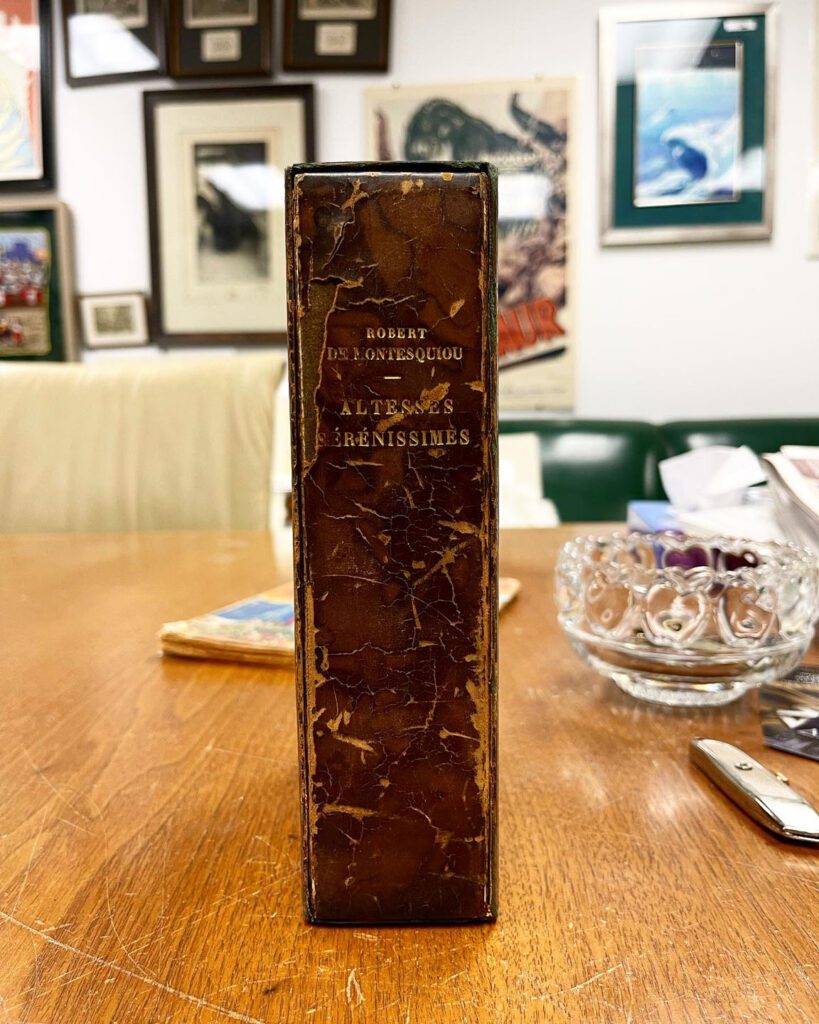
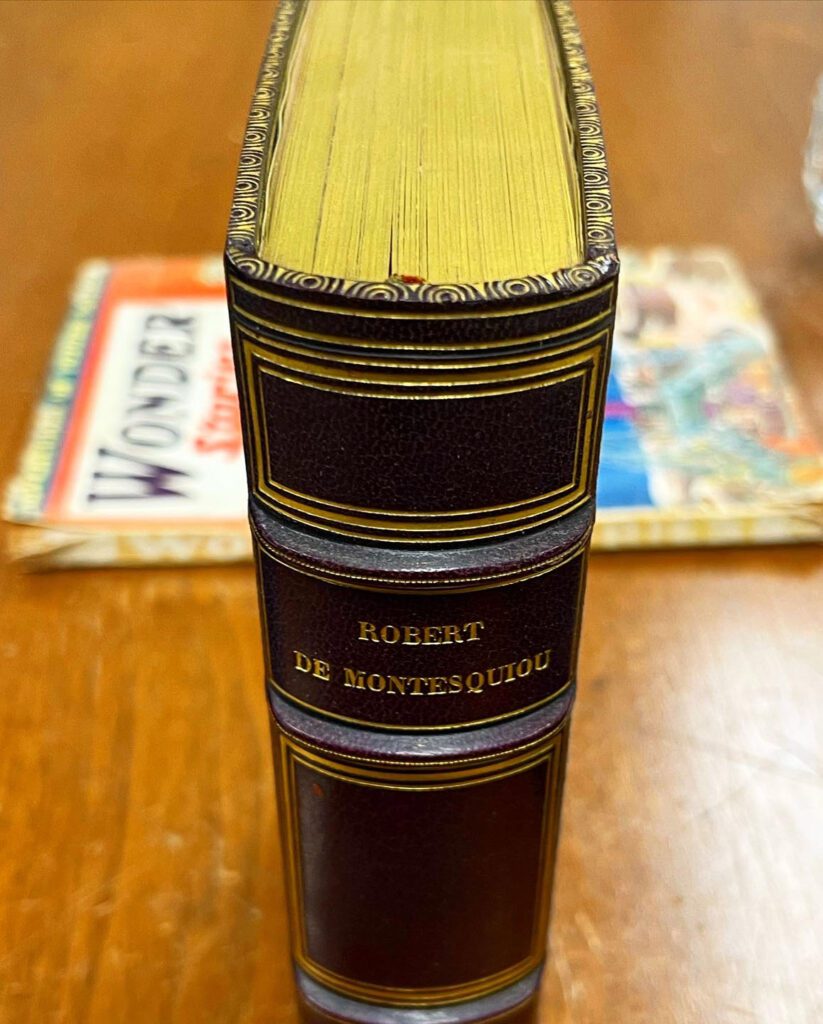
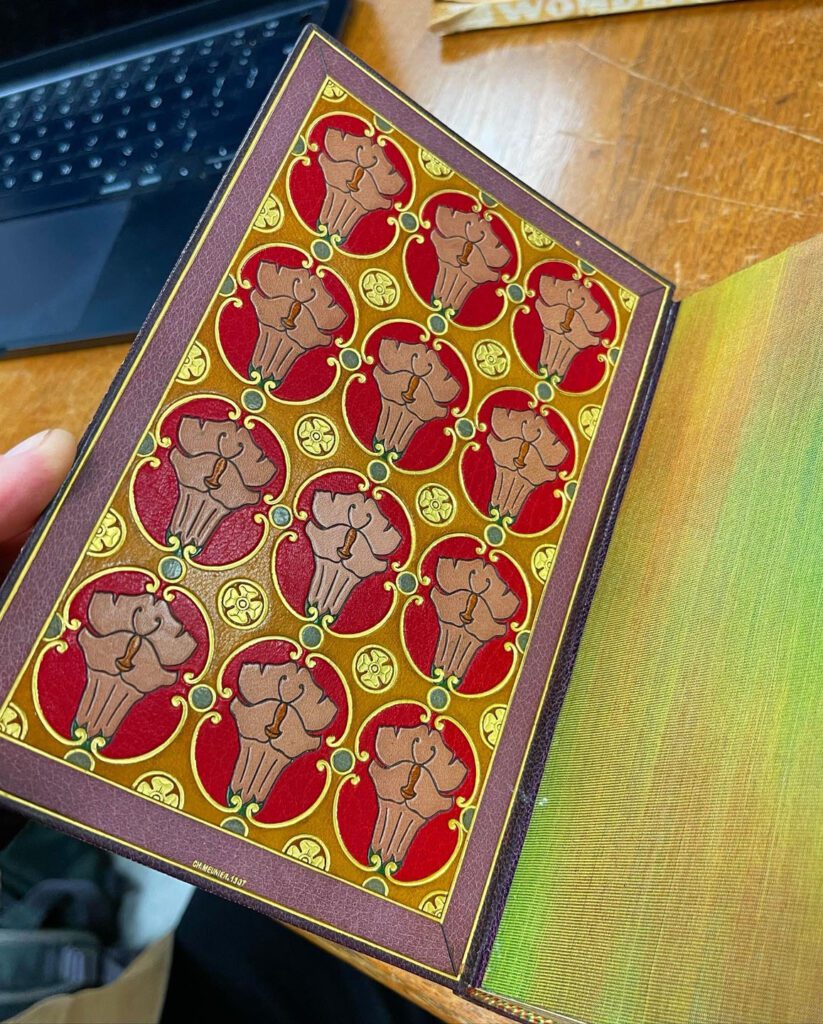
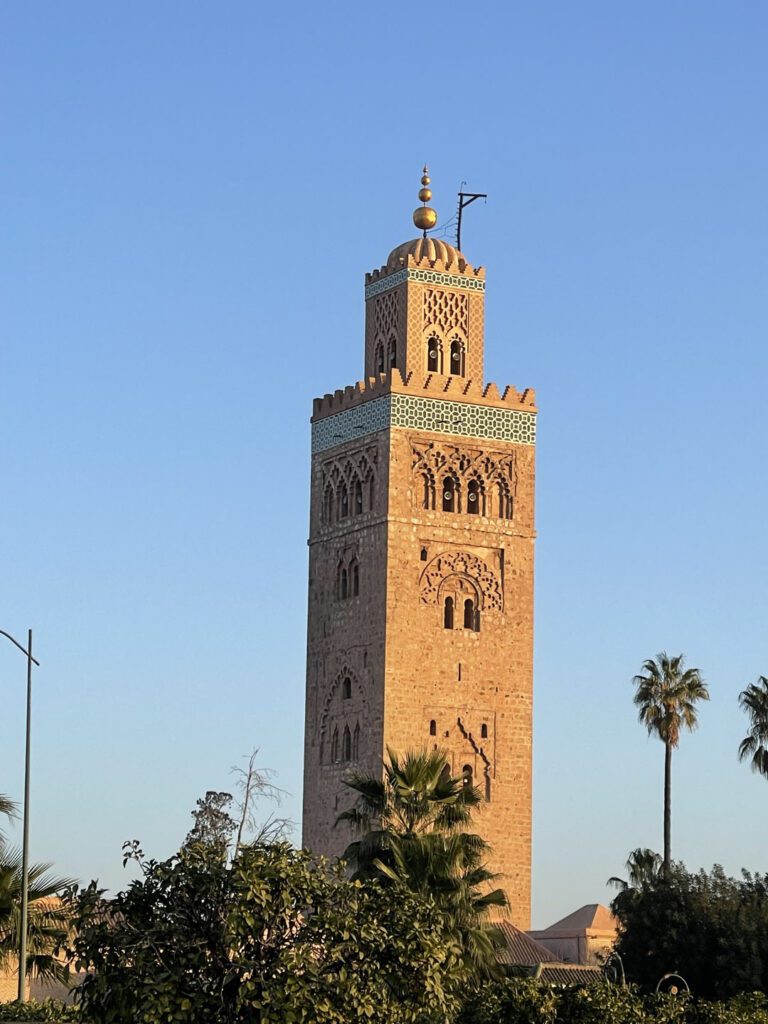
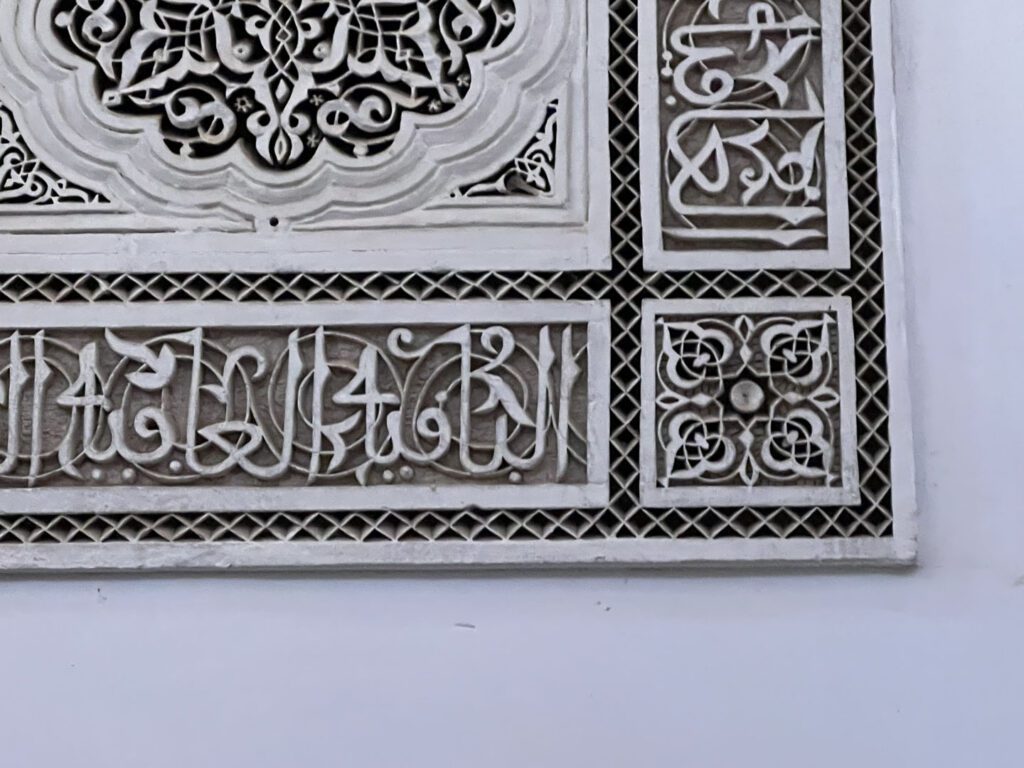
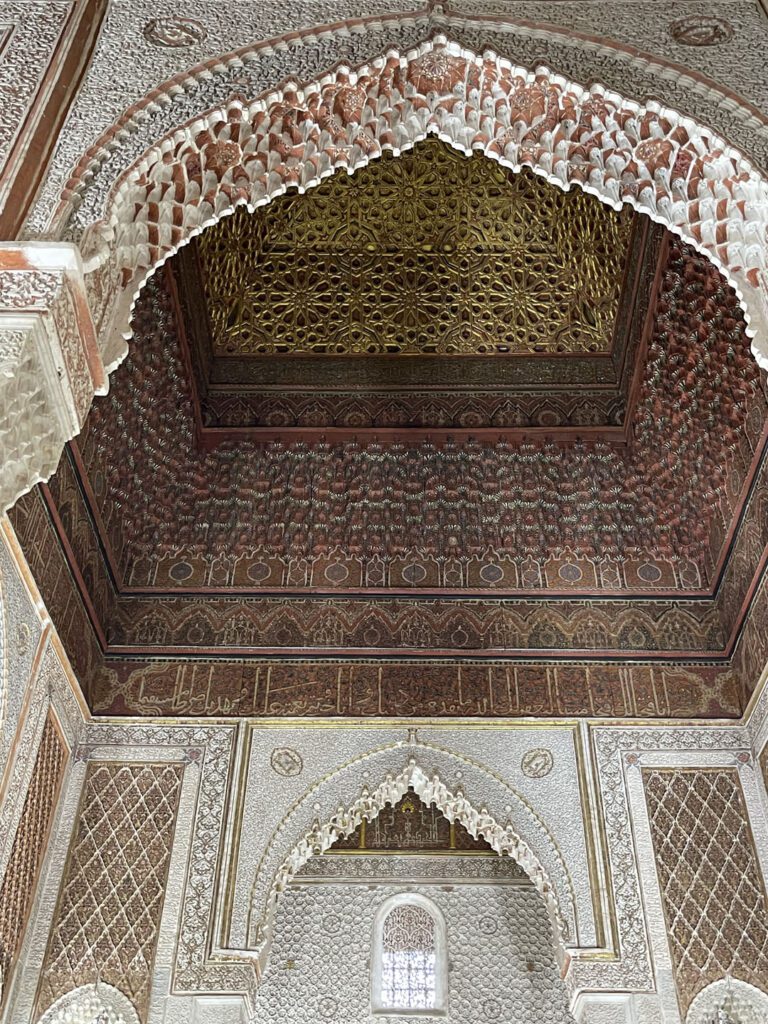
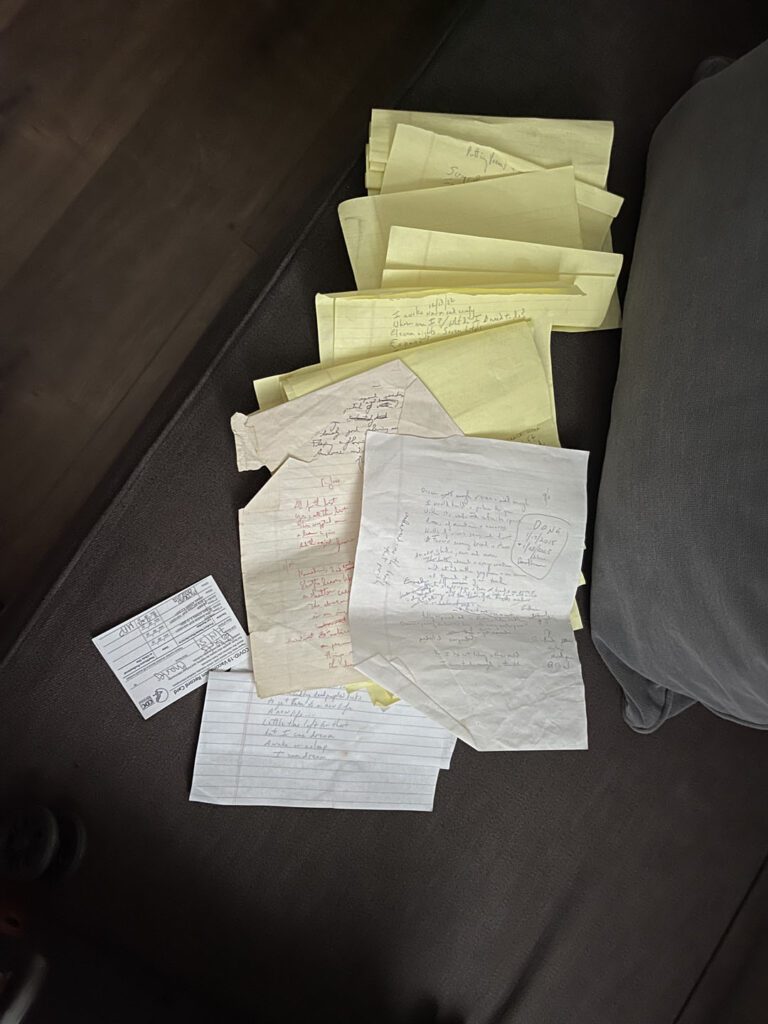
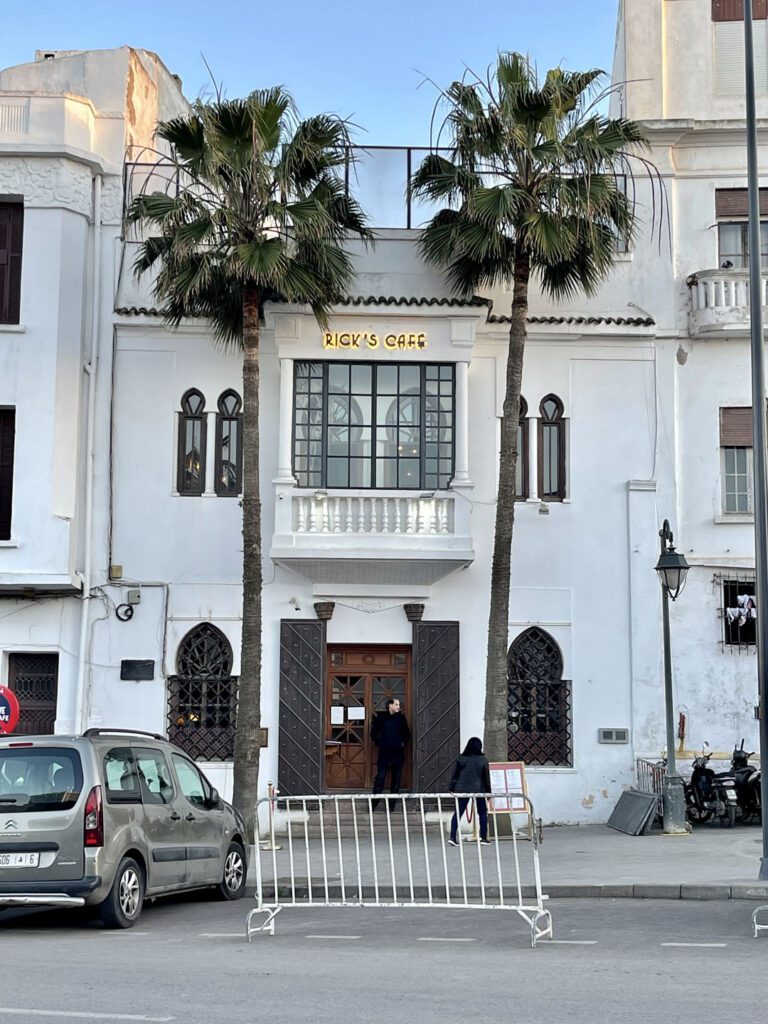
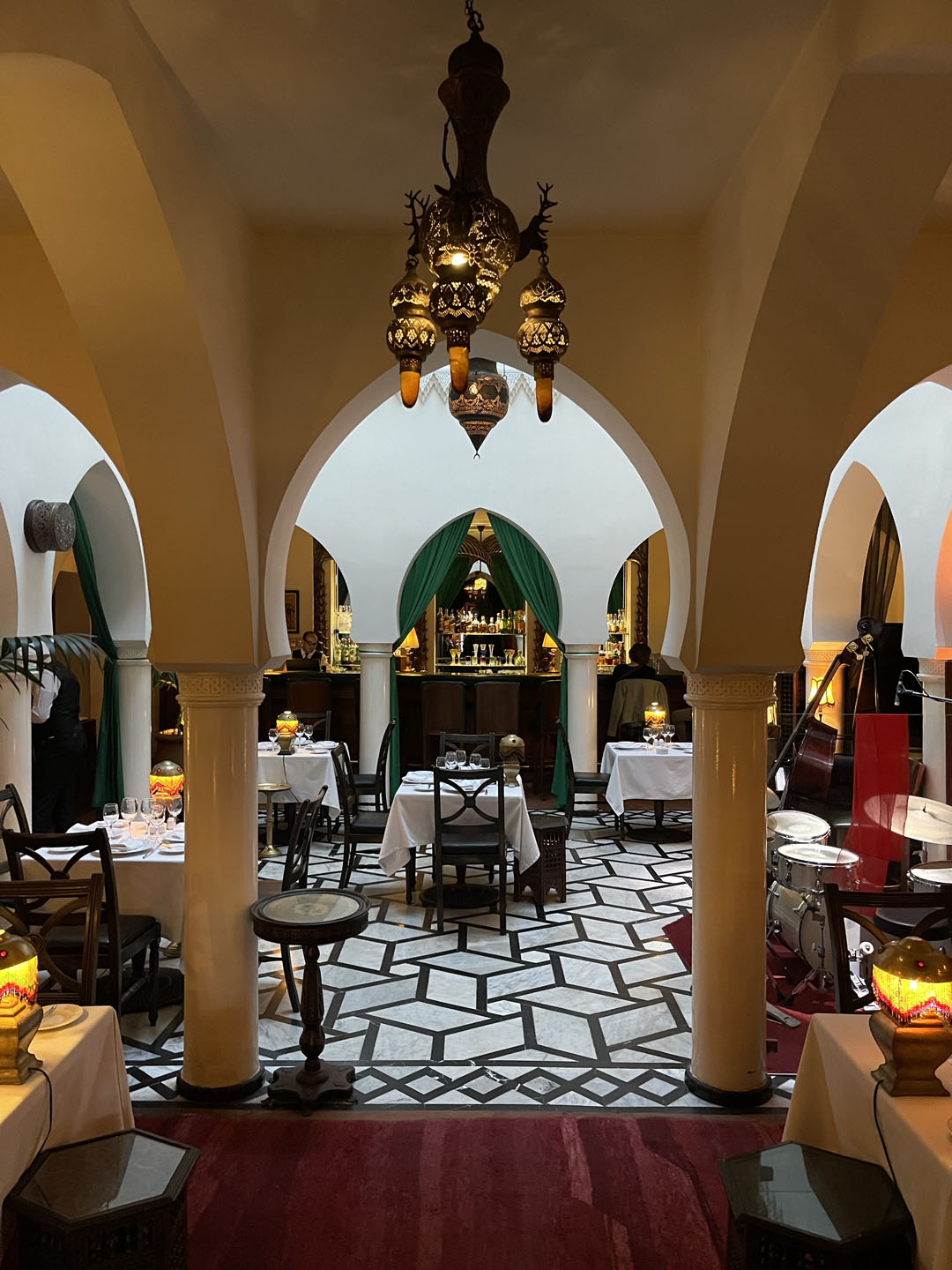
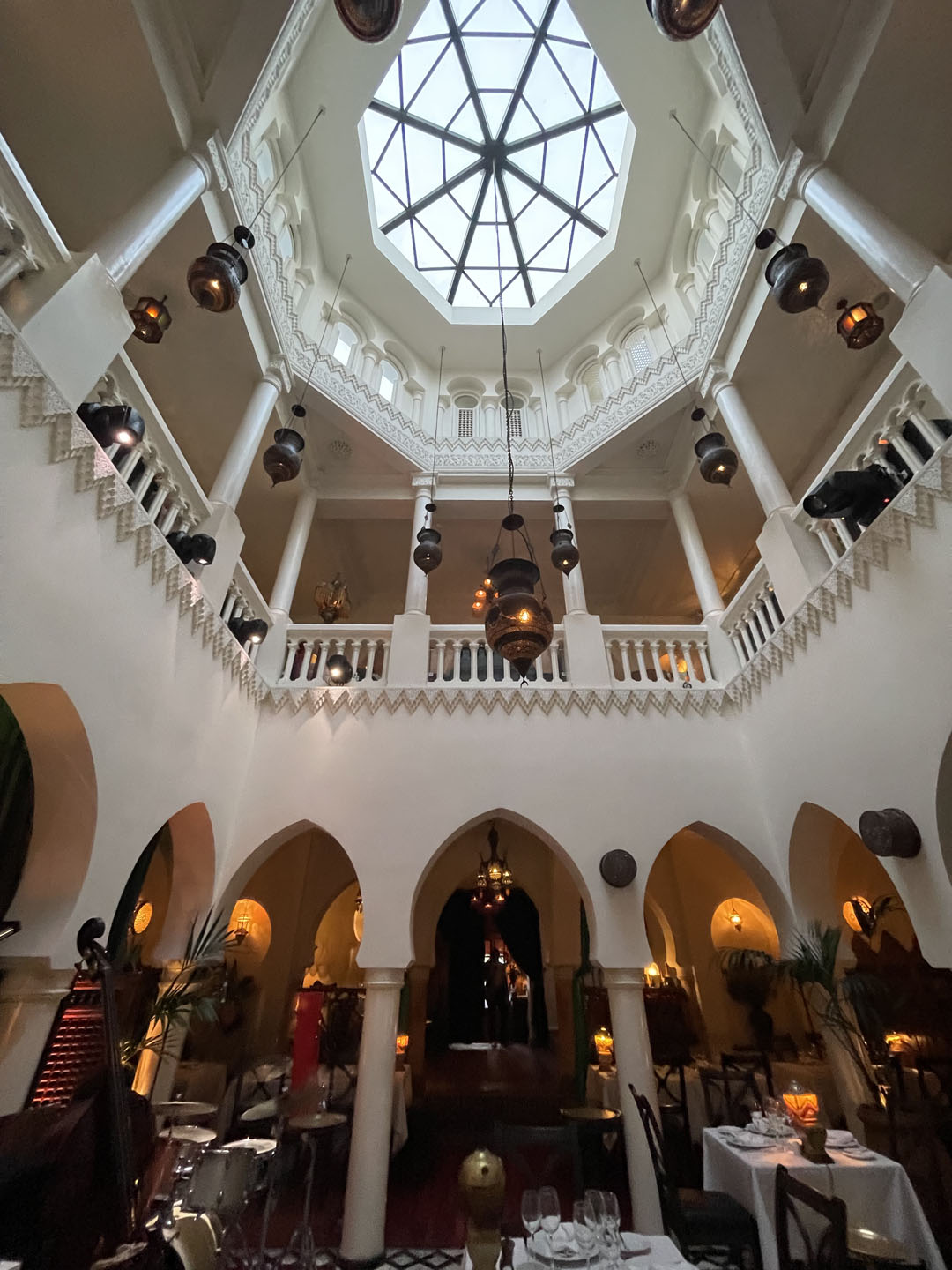
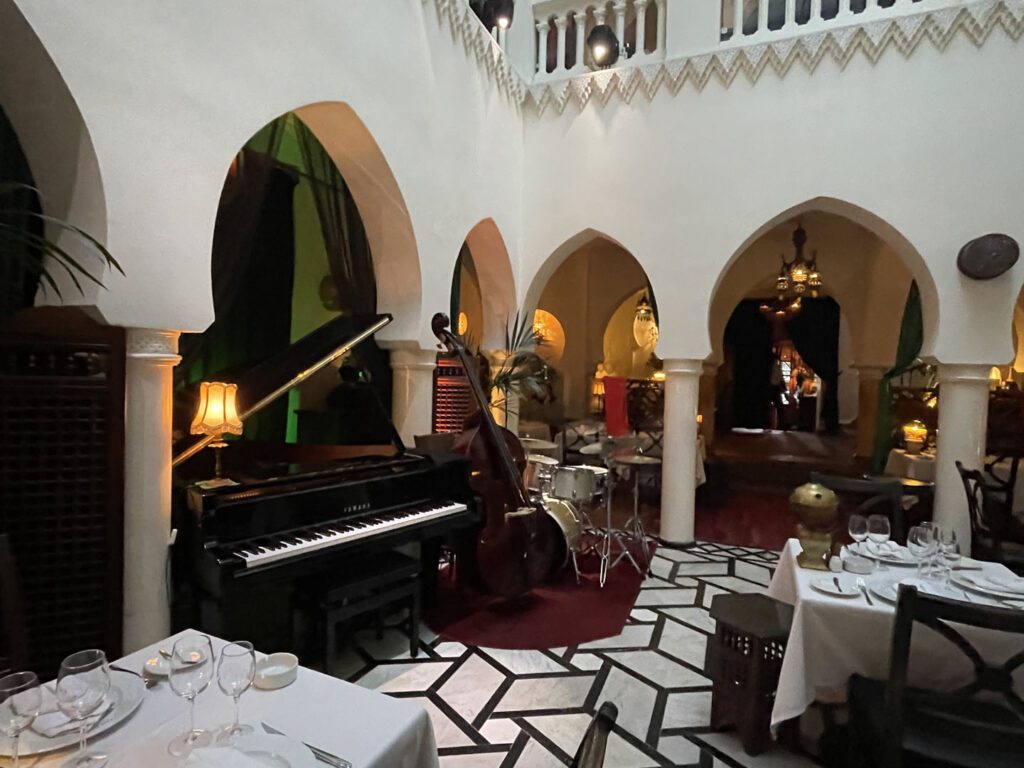
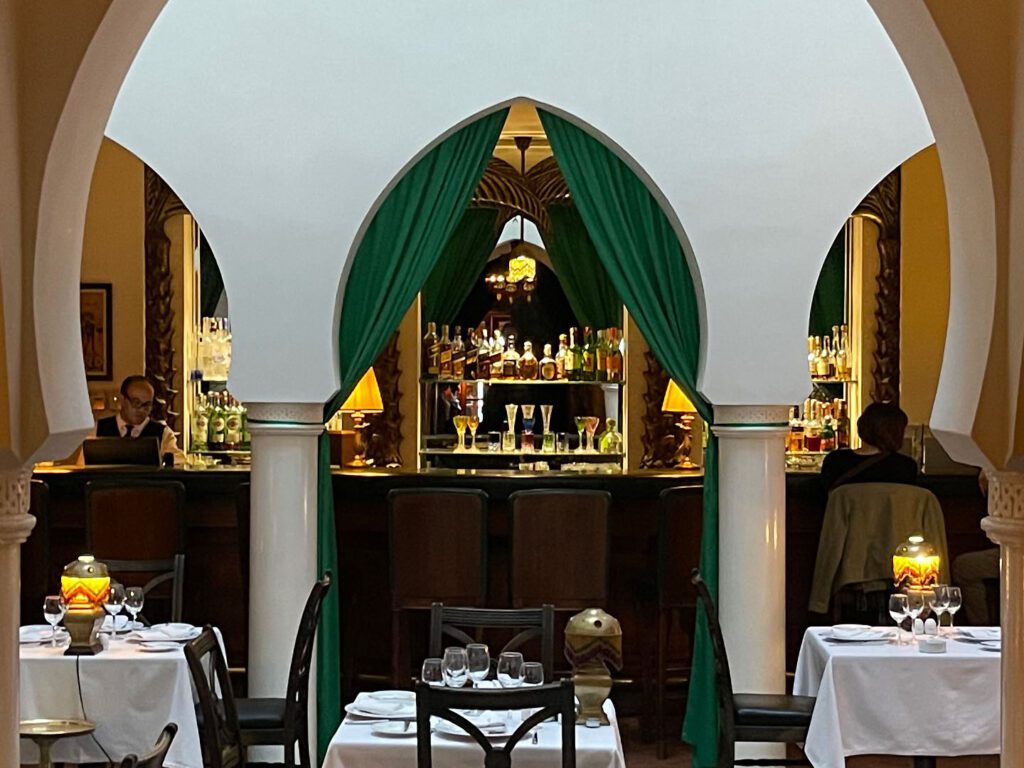
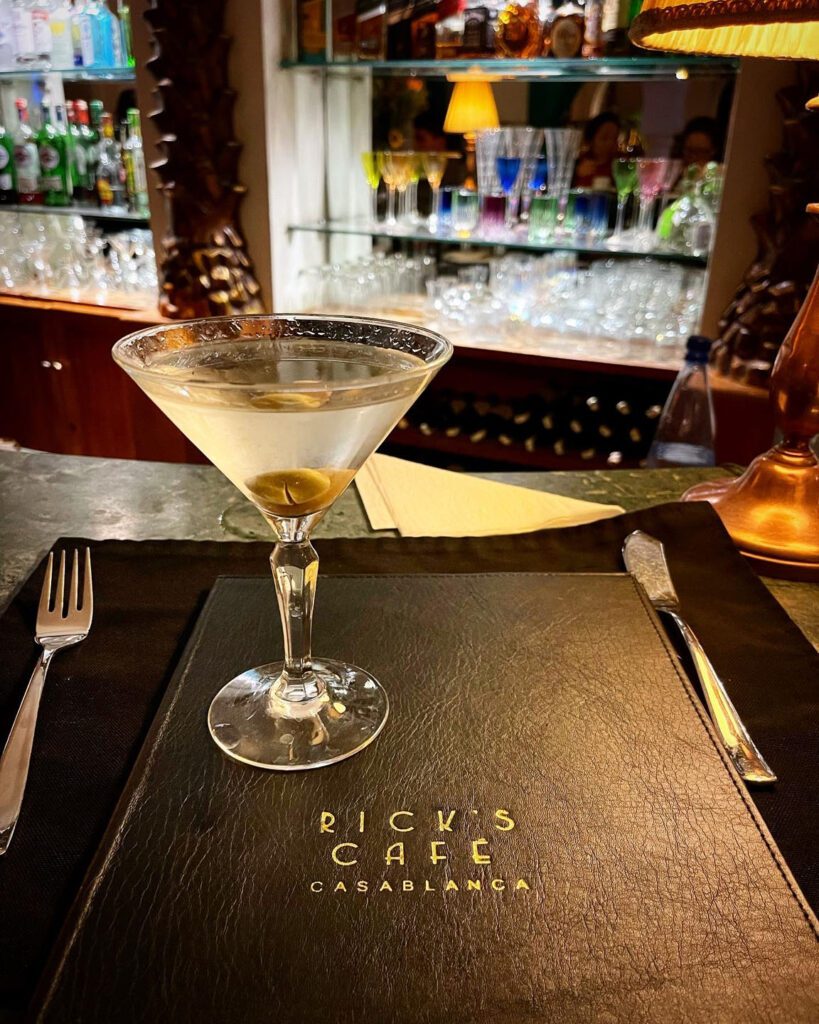
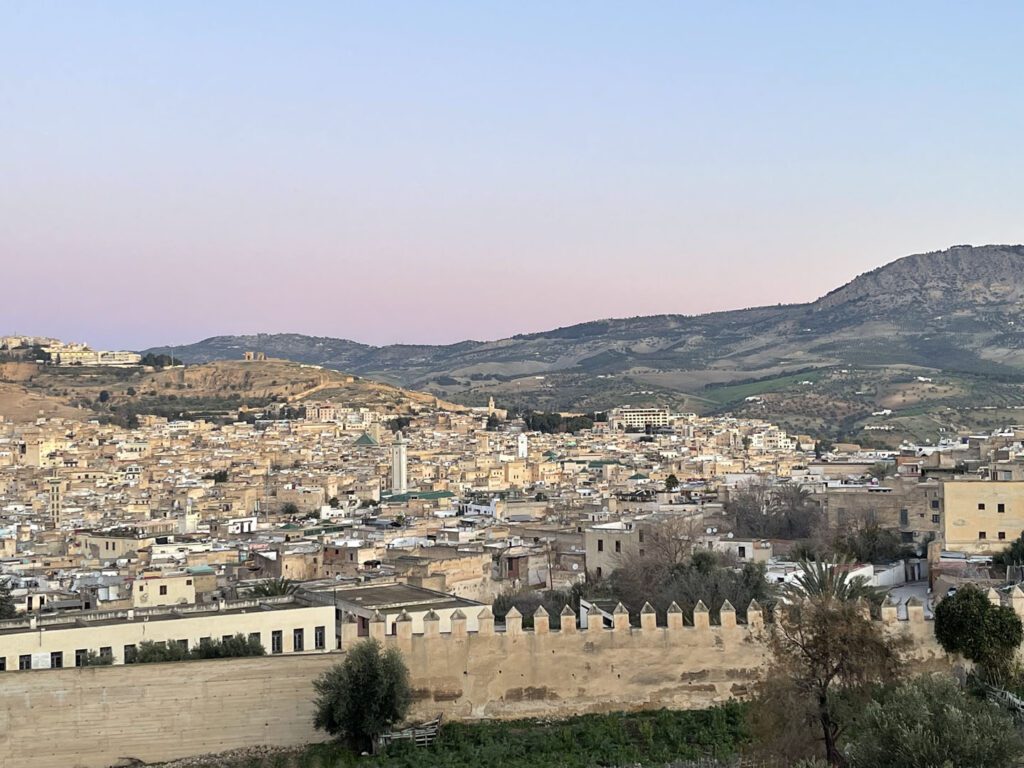
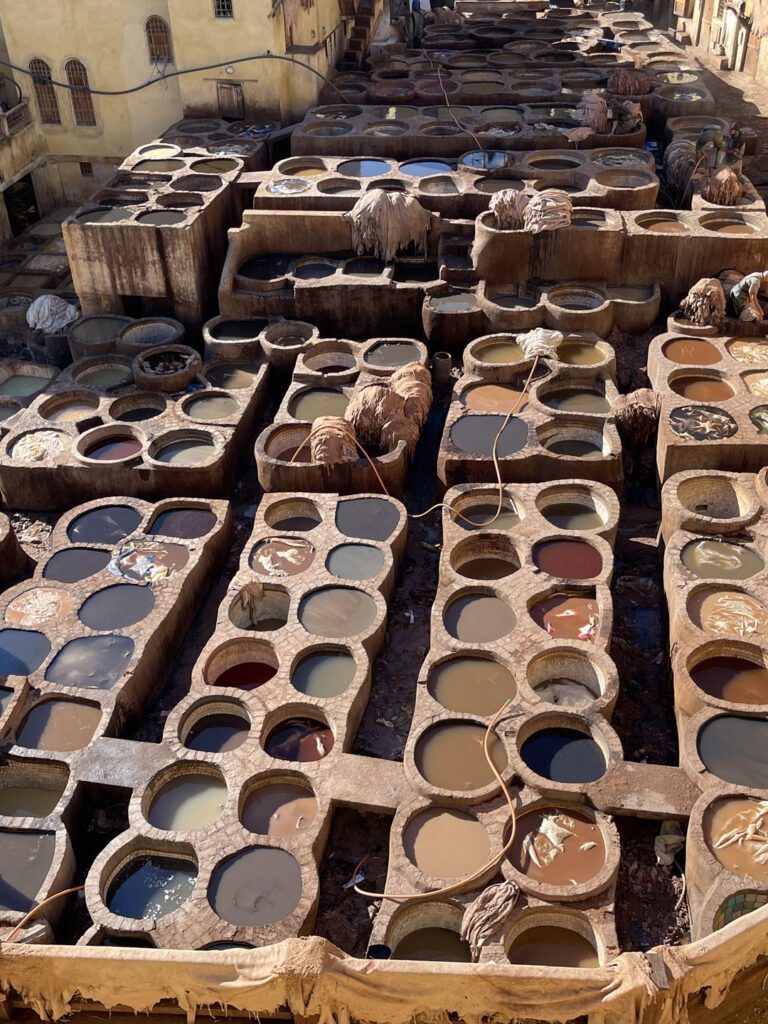
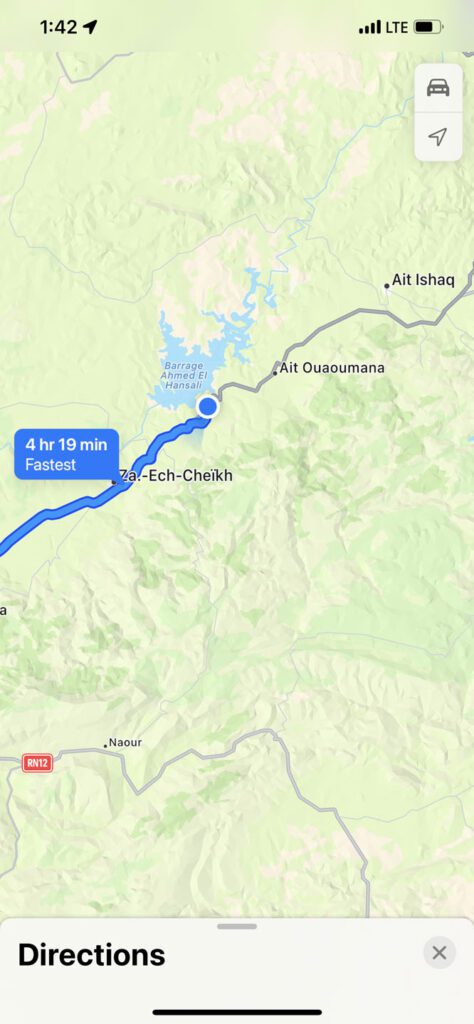
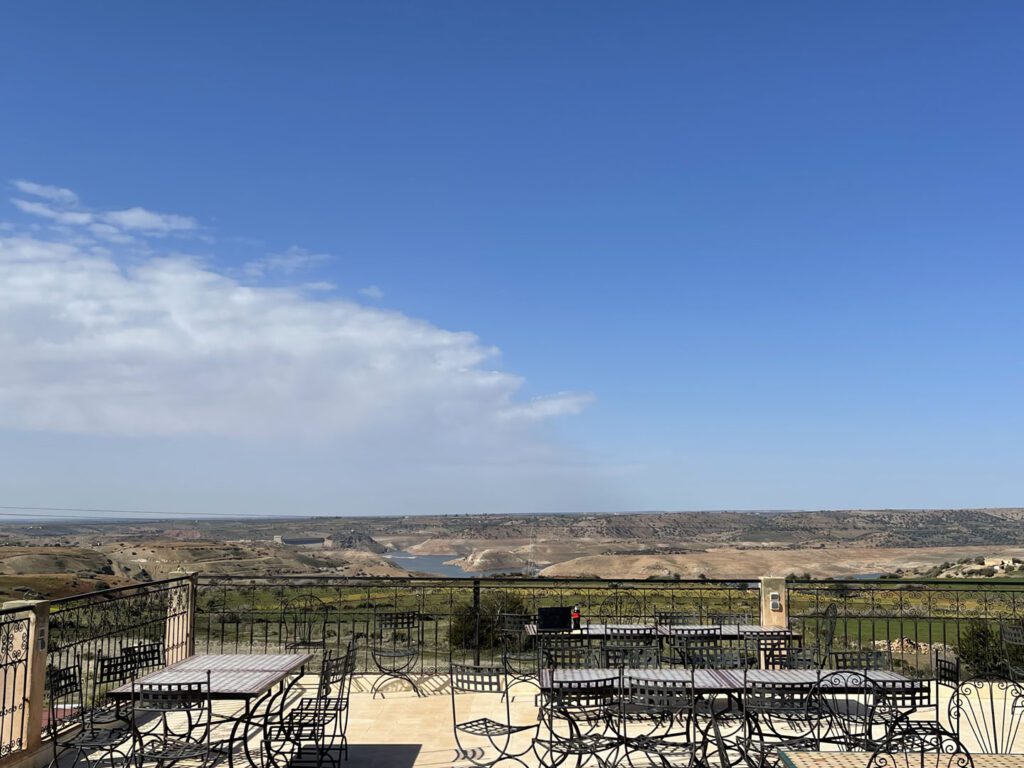
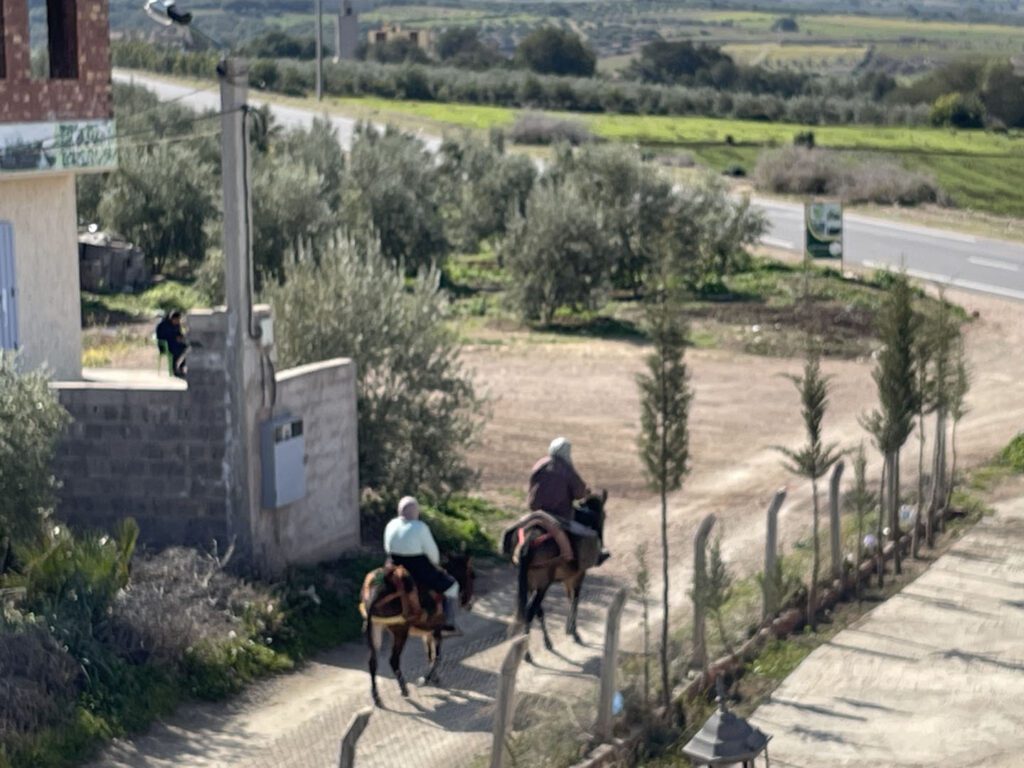
From the stamp on the end paper came this and more references. This from 2005. Thanks for taking me along on a trip that will never happen for me. Kinda wondered what Casablanca was like these days… https://www.christies.com/en/lot/lot-4458355
That is so cool!
Thanks you for sending it on!
Chuck
I like your Montesquiou item. I have a good collection of Robert de Montesquiou books. Interesting chap and a convoluted poet. I think your title was probably specially bound for him, a practice of which he was fond being a wealthy dilettante…
It is a beauty!
Thank you for reading and commenting!
Chuck